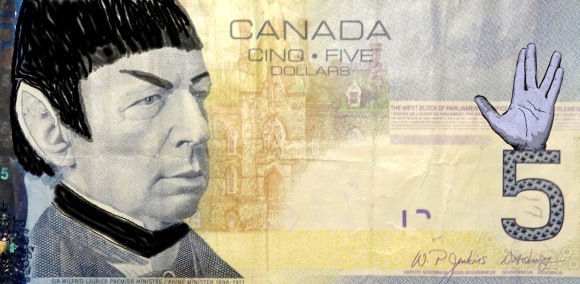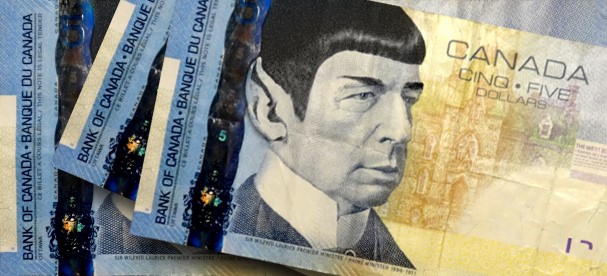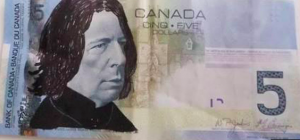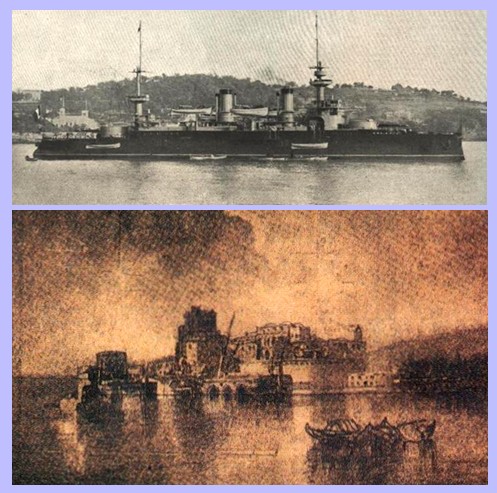aNewDomain — Late actor Leonard Nimoy was no stranger to the Canadian five dollar bill. Neither is Alan Rickman. For years now, Canadians have been “spocking” and “snaping” their five dollar bills, transforming the image of former Canadian prime minister Wilfrid Laurier into Star Trek’s Mr. Spock (Nimoy) and Harry Potter’s Severus Snape (Rickman).
The practice isn’t illegal. A new, plastic version of the Canadian fiver is about to doom the practice anyway. But for now, and especially with Nimoy’s recent death, Canadians are spocking Canadian bills in greater than ever numbers.
So many Canadians have been altering the currency that the Bank of Canada yesterday announced that the practice of “spocking” will require the country to print new notes at a faster than normal rate. Noting the huge number of snaped and spocked bills now in circulation, the Bank of Canada is asking Canadians to stop with the spocking and snaping, saying that drawing on bills with ink could get in the way of banking security features — and reduce the lifespan of bills in general.
The lifespan of spocking is limited anyhow, bank officials say. In November 2015, the Bank of Canada will enter a new, polymer-based five dollar bill into circulation. Plastic bills aren’t as easy to write on.
More importantly, they say, the image of Laurier on the new bill doesn’t look as much like Spock or Snape.
The five dollar bill is Canada’s smallest denomination of paper currency. The Canadian dollar is a coin, known as the Loonie, because of the common loon featured on its reverse side.
Short lived as it will be, spocking and snaping are examples of what art experts call metamorphic art.
That’s the the practice of taking an existing object and transforming it into something else. Mexican artist Octavio Ocampo excels in this form of art, and famed landscape painter Thomas Moran was known to have taken his morning newspaper and turned the photographs of presidents and battleships into castles and railroads (See below).
With the help of our resident art director, Tim Downs, we tried our hand at some good old Canadian spocking.
I transformed the Canadian five from this:
 … into this
… into this

Our art director Tim Downs also tried his hand at some spocking.

Spock and Snape aren’t the only literary figures who get metamorphic art treatment, we should add. Canadians have turned their former prime minister into characters from Star Wars movies and into Goth rock stars.
Here’s a snaped bill, below.

This is one of those things you can’t do better in America.
US currency, though printed in greater volumes, is less amenable to morphing because most of the images (presidents Washington, Franklin, Jefferson, Jackson, and Hamilton) are dressed in an 18th century style and even the more modern ones (presidents Lincoln and Grant) are printed in heavy green and gray colors.
Metaphoric art can be found in most European currency – occasionally the Queen can be found with broad smile, for example.
Here is an example of Thomas Moran’s metamorphic art. In March 1907, the French battleship Iéna (topmost image below) exploded, killing several hundred sailors. News of the explosion was flashed around the world and photographs of the wreckage appeared in newspapers all over the world. Moran took the image of the wrecked ship and turned it into the seaside castle shown in the lower image.

For aNewDomain, I’m Tom Ewing.
Photo credits: Tim Downs original art, Canadian $5 bill photograph, Tom Ewing, spocked $5 bill by Tom Ewing. Snaped bill: Twitter.
French Battleship Jena, courtesy Wikipedia.
Thomas Moran metamorphic art, Southwest Art Magazine Oct 1986, p 60.













Nimoy was American and Snape is/was British. When Leonard Cohen passes on, I propose that he be put on the Canadian fiver and Sir Wilfred retired.